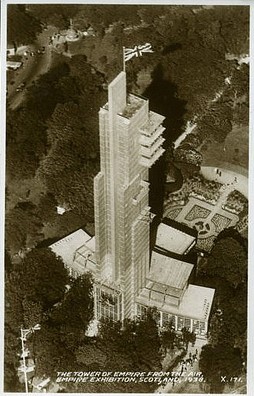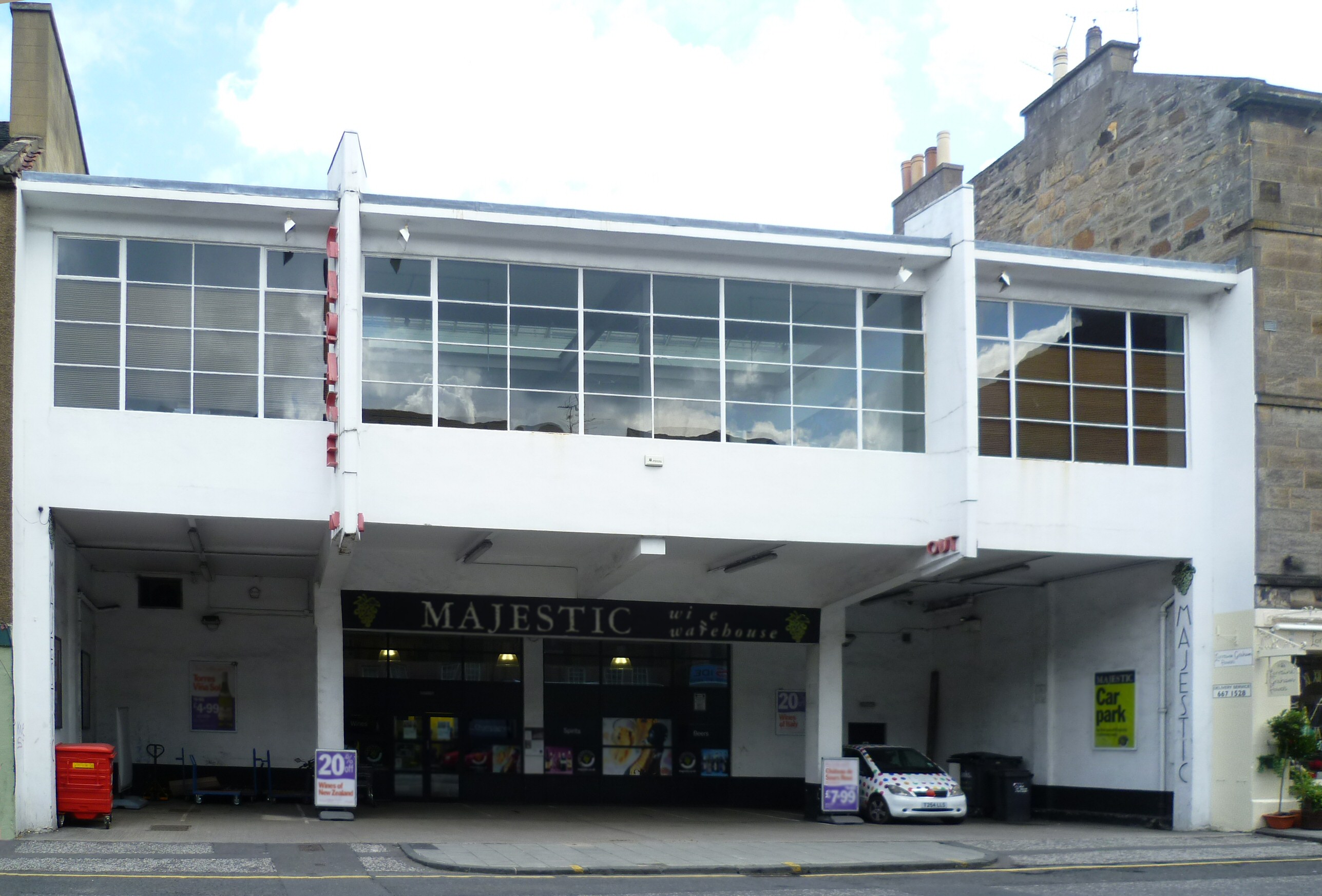|
Empire Exhibition, Scotland 1938
Empire Exhibition, Scotland 1938 was an international exposition held at Bellahouston Park in Glasgow, from May to December 1938. The Exhibition offered a chance to showcase and boost the economy of Scotland, and celebrate Empire trade and developments, recovering from the depression of the 1930s. It also marked fifty years since Glasgow's first great exhibition, the International Exhibition (1888) held at Kelvingrove Park. It was the second British Empire Exhibition, the first having been held at Wembley Park, London in 1924 and 1925. Its function was similar to the first National Exhibition in Paris in 1798, and to the first International Exhibition, the Great Exhibition in London in 1851 attended by 6 million visitors. It was declared open by King George VI and Queen Mary on 3 May 1938 at the Opening Ceremony in Ibrox Stadium, attended by 146,000 people. In addition to the Royal Patrons and the Honorary Presidents representing governments and institutions here ... [...More Info...] [...Related Items...] OR: [Wikipedia] [Google] [Baidu] |
Tait Tower
Tait Tower (also known as Tait's Tower and officially as the Tower of Empire) was a tower in the art deco style constructed at the summit of Ibrox Hill in Bellahouston Park in Glasgow in Scotland as part of the Empire Exhibition, Scotland 1938. It was designed by Thomas S. Tait, stood high and had three separate observation decks which provided a view of the surrounding gardens and city. Due to both the height of the tower and the hill it was built on, it could be seen away. The tower was the centrepiece of the Empire Exhibition and its image featured on many of the souvenirs that could be bought at the exhibition site. The Empire Exhibition took place at a time when Glasgow was the centre of British shipbuilding and engineering, and the materials – steel beams riveted together and clad in corrugated steel – were produced by Glasgow manufacturing plants. Tait's design and readily available materials made it possible for the tower to be constructed in only nine weeks. The ... [...More Info...] [...Related Items...] OR: [Wikipedia] [Google] [Baidu] |
Wembley Park
Wembley Park is a district of the London Borough of Brent, England. It is roughly centred on Bridge Road, a mile northeast of Wembley town centre and northwest from Charing Cross. The name Wembley Park refers to the area that, at its broadest, falls within the limits of a late 18th-century landscaped estate in northern Wembley in the historic Middlesex county. Part of this estate became the location of development in the 1890s after being sold to Edward Watkin and the Metropolitan Railway cutting through the area. Wembley Park was developed into a pleasure and events destination for urban Londoners, with a large fairground made there. It was later also a key area of the Metro-land suburban development in the 1920s - the same decade Empire Stadium was built and the British Empire Exhibition was held. Wembley Park continues to be a recreational centre today, being home to Wembley Stadium, England's primary football stadium and a major sports and entertainment venue; as well as W ... [...More Info...] [...Related Items...] OR: [Wikipedia] [Google] [Baidu] |
Art Deco
Art Deco, short for the French ''Arts Décoratifs'', and sometimes just called Deco, is a style of visual arts, architecture, and product design, that first appeared in France in the 1910s (just before World War I), and flourished in the United States and Europe during the 1920s and 1930s. Through styling and design of the exterior and interior of anything from large structures to small objects, including how people look (clothing, fashion and jewelry), Art Deco has influenced bridges, buildings (from skyscrapers to cinemas), ships, ocean liners, trains, cars, trucks, buses, furniture, and everyday objects like radios and vacuum cleaners. It got its name after the 1925 Exposition internationale des arts décoratifs et industriels modernes (International Exhibition of Modern Decorative and Industrial Arts) held in Paris. Art Deco combined modern styles with fine craftsmanship and rich materials. During its heyday, it represented luxury, glamour, exuberance, and faith in socia ... [...More Info...] [...Related Items...] OR: [Wikipedia] [Google] [Baidu] |
Design Council
The Design Council, formerly the Council of Industrial Design, is a United Kingdom charity incorporated by Royal Charter. Its stated mission is "to champion great design that improves lives and makes things better". It was instrumental in the promoting of the concept of inclusive design. The Design Council's archive is located at the University of Brighton Design Archives. The Design Council operates two subsidiaries, the Design Council Commission for Architecture and the Built Environment (Design Council CABE) and Design Council Enterprises Limited. The Commission for Architecture and the Built Environment The Design Council Commission for Architecture and the Built Environment (DC CABE, alternatively Design Council CABE, CABE at the Design Council, or simply CABE), is one of Design Council’s two subsidiaries. It supports communities, local authorities and developers involved in built environment projects by providing services in three areas: design review, customised exper ... [...More Info...] [...Related Items...] OR: [Wikipedia] [Google] [Baidu] |
Sir James Lithgow, 1st Baronet
Sir James Lithgow, 1st Baronet, (27 January 1883 – 23 February 1952) was a Scottish industrialist who played a major role in restructuring the British shipbuilding and steelmaking industries in the 1930s in addition to playing an important role in formulating public policy and supervising wartime production.James Lithgow at geo.ed.uk Retrieved 18 February 2008 Early life James was born in , Scotland, the son of William Todd Lithgow; in the same year his parents moved to |
University Of Glasgow
, image = UofG Coat of Arms.png , image_size = 150px , caption = Coat of arms Flag , latin_name = Universitas Glasguensis , motto = la, Via, Veritas, Vita , mottoeng = The Way, The Truth, The Life , established = , type = Public research universityAncient university , endowment = £225.2 million , budget = £809.4 million , rector = Rita Rae, Lady Rae , chancellor = Dame Katherine Grainger , principal = Sir Anton Muscatelli , academic_staff = 4,680 (2020) , administrative_staff = 4,003 , students = () , undergrad = () , postgrad = () , city = Glasgow , country = Scotland, UK , colours = , website = , logo ... [...More Info...] [...Related Items...] OR: [Wikipedia] [Google] [Baidu] |
Jack Coia
Gillespie, Kidd & Coia was a Scottish architectural firm famous for their application of modernism in churches and universities, as well as at St Peter's Seminary in Cardross. Though founded in 1927, they are best known for their work in the post-war period. The firm was wound up in 1987. In 2007, the firm was the subject of a major retrospective exhibition at The Lighthouse, Glasgow. History of the practice Origins The Scottish architect James Salmon (1805–1888) established a practice in Glasgow in 1830. John Gaff Gillespie (1870–1926) was hired in 1891, when the practice was known as James Salmon & Son, and was run by the son, William Forrest Salmon. The practice name was changed in 1903 to Salmon & Son & Gillespie, with James Salmon (1873–1924), grandson of the founder, and John Gaff Gillespie as partners. William Alexander Kidd (1879–1928) joined the firm in 1898, becoming a partner, with Gillespie, in 1918 (James Salmon had left the firm in 1913). Kidd beca ... [...More Info...] [...Related Items...] OR: [Wikipedia] [Google] [Baidu] |
Basil Spence
Sir Basil Urwin Spence, (13 August 1907 – 19 November 1976) was a Scottish architect, most notably associated with Coventry Cathedral in England and the Beehive in New Zealand, but also responsible for numerous other buildings in the Modernist/ Brutalist style. Training Spence was born in Bombay, Bombay Presidency, British India,Let's be frank about Spence ''The Guardian'' (16 October 2007). Retrieved: 10 October 2021. the son of Urwin Archibald Spence, an assayer with the . He was educated at the John Connon School, operated by the Bombay Scottish Education Society, and was th ... [...More Info...] [...Related Items...] OR: [Wikipedia] [Google] [Baidu] |
Thomas S
Thomas may refer to: People * List of people with given name Thomas * Thomas (name) * Thomas (surname) * Saint Thomas (other) * Thomas Aquinas (1225–1274) Italian Dominican friar, philosopher, and Doctor of the Church * Thomas the Apostle * Thomas (bishop of the East Angles) (fl. 640s–650s), medieval Bishop of the East Angles * Thomas (Archdeacon of Barnstaple) (fl. 1203), Archdeacon of Barnstaple * Thomas, Count of Perche (1195–1217), Count of Perche * Thomas (bishop of Finland) (1248), first known Bishop of Finland * Thomas, Earl of Mar (1330–1377), 14th-century Earl, Aberdeen, Scotland Geography Places in the United States * Thomas, Illinois * Thomas, Indiana * Thomas, Oklahoma * Thomas, Oregon * Thomas, South Dakota * Thomas, Virginia * Thomas, Washington * Thomas, West Virginia * Thomas County (other) * Thomas Township (other) Elsewhere * Thomas Glacier (Greenland) Arts, entertainment, and media * ''Thomas'' (Burton novel) 1969 novel ... [...More Info...] [...Related Items...] OR: [Wikipedia] [Google] [Baidu] |
British Empire
The British Empire was composed of the dominions, colonies, protectorates, mandates, and other territories ruled or administered by the United Kingdom and its predecessor states. It began with the overseas possessions and trading posts established by England between the late 16th and early 18th centuries. At its height it was the largest empire in history and, for over a century, was the foremost global power. By 1913, the British Empire held sway over 412 million people, of the world population at the time, and by 1920, it covered , of the Earth's total land area. As a result, its constitutional, legal, linguistic, and cultural legacy is widespread. At the peak of its power, it was described as "the empire on which the sun never sets", as the Sun was always shining on at least one of its territories. During the Age of Discovery in the 15th and 16th centuries, Portugal and Spain pioneered European exploration of the globe, and in the process established large overse ... [...More Info...] [...Related Items...] OR: [Wikipedia] [Google] [Baidu] |
Mary Of Teck
Mary of Teck (Victoria Mary Augusta Louise Olga Pauline Claudine Agnes; 26 May 186724 March 1953) was List of British royal consorts, Queen of the United Kingdom and the British Dominions, and Empress of India, from 6 May 1910 until 20 January 1936 as the wife of King-Emperor George V. Born and raised in the United Kingdom of Great Britain and Ireland, United Kingdom, Mary was the daughter of Francis, Duke of Teck, a German nobleman, and Princess Mary Adelaide of Cambridge, a granddaughter of King George III and a minor member of the British royal family. She was informally known as "May", after the month of her birth. At the age of 24, she was betrothed to her second cousin once removed Prince Albert Victor, Duke of Clarence and Avondale, the eldest son of the Edward VII, Prince of Wales and second in line to the throne. Six weeks after the announcement of the engagement, he died unexpectedly during an 1889–1890 pandemic, influenza pandemic. The following year, she became ... [...More Info...] [...Related Items...] OR: [Wikipedia] [Google] [Baidu] |


.jpg)
_interior.jpg)

.jpg)



